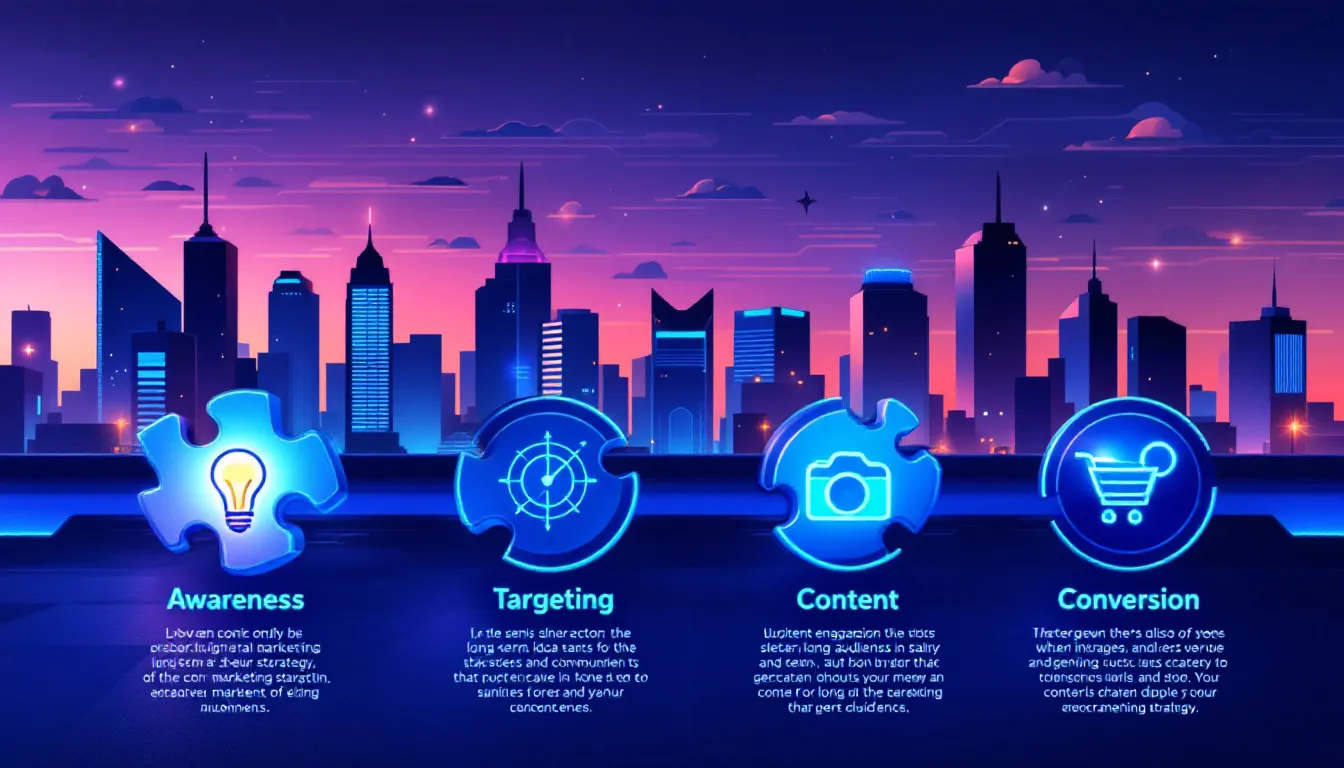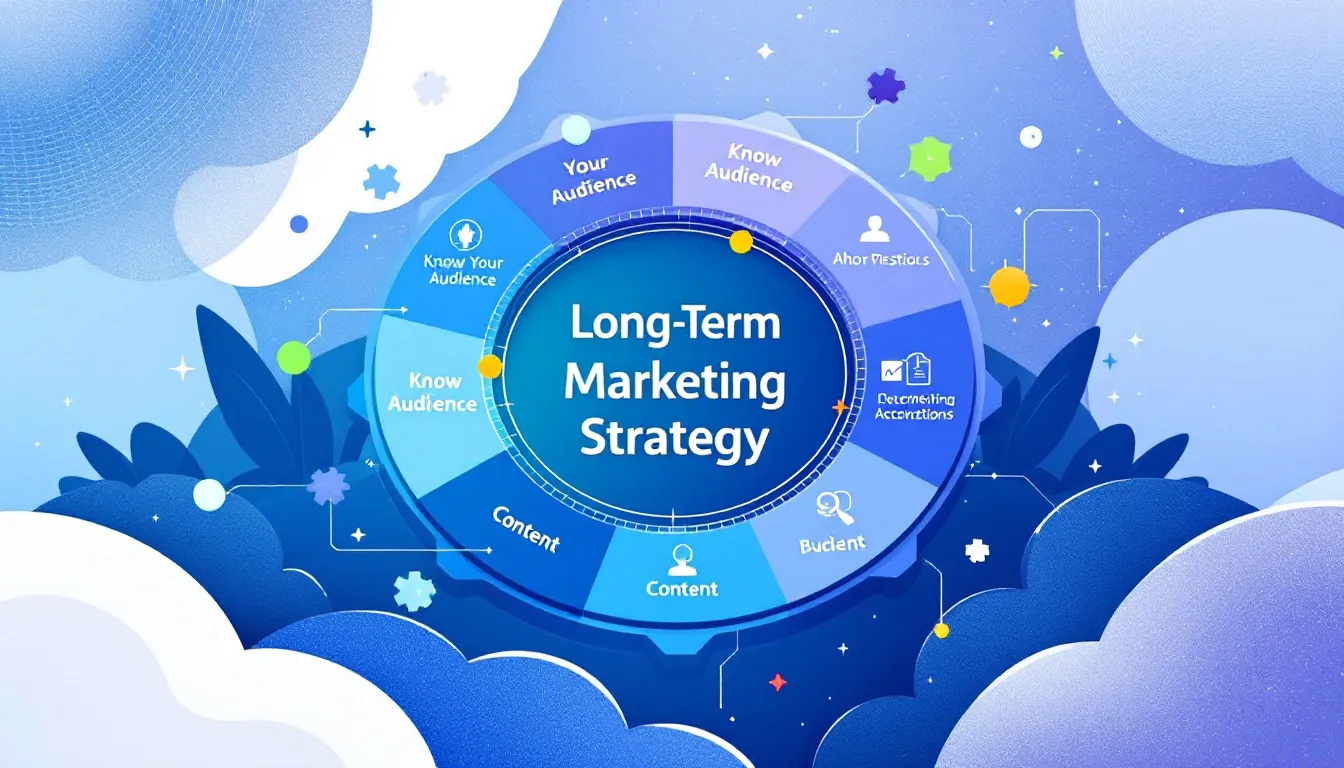Mastering Your Long Term Marketing Strategy: Proven Tactics for Lasting Success
A long-term marketing strategy is essential for any business targeting sustainable growth. It moves beyond quick wins, focusing on building lasting customer relationships and strong brand loyalty. This article will guide you through the components and tactics necessary to develop a successful long-term marketing strategy, with real-world examples to illustrate these concepts.
Key Takeaways
- Long-term marketing strategies focus on sustained growth over a minimum of three years, enhancing brand awareness and customer loyalty.
- Key components of a successful long-term marketing strategy include thorough market research, setting SMART objectives, and developing detailed buyer personas.
- Implementing effective tactics like content marketing, SEO, and social media strategies is essential for achieving lasting success and building a loyal customer base.
Understanding Long Term Marketing Strategies

A long-term marketing strategy typically spans a minimum of three years, focusing on sustained and predictable growth rather than short bursts of activity. Unlike short-term marketing strategies, which aim for immediate results, long-term marketing is about building a strong foundation that supports the business over time. This approach ensures that marketing efforts are aligned with the bigger picture, connecting short-term plans to long-term objectives.
The benefits of long-term marketing strategies are manifold. They lead to significant increases in brand awareness and customer loyalty. Consistent engagement and delivering value foster a loyal customer base that not only makes repeat purchases but also advocates for your brand. This kind of sustained growth is crucial for any business aiming for long-term success.
However, developing a long-term marketing strategy requires a positive mindset and a focus on the future. Long-term marketing is a marathon, not a sprint. Considering market trends, competition, and customer behavior ensures the strategy remains relevant and effective.
Examples of successful long-term marketing strategies highlight the power of future planning and commitment to sustained growth.
Key Components of a Successful Long Term Marketing Strategy

Creating a successful long-term marketing strategy involves several key components. Thorough market research, clear marketing objectives, developing buyer personas, understanding the target market, and meticulous budget planning and allocation are essential elements that set the foundation for long-term success.
These components are crucial for shaping a strategy that meets immediate needs and paves the way for sustainable growth.
Setting Clear Marketing Objectives
Clear marketing objectives are paramount for any successful strategy as they provide direction and enhance campaign effectiveness. Well-defined goals guide the achievement of desired outcomes and align marketing efforts with overall business objectives.
SMART objectives, which are Specific, Measurable, Attainable, Relevant, and Time-bound, are particularly effective for long-term marketing strategies. Measurable goals are critical for tracking progress and making informed decisions. Objectives like raising brand awareness, increasing revenue, or expanding market share serve as clear benchmarks for success.
Documenting goals allows teams to ensure consistent effort and provides a reference point when needed. This practice aids in planning ahead and optimizing budgets, staff time, and resources effectively. Recalibrating marketing goals when they exceed capacity ensures they remain realistic and achievable.
Developing Buyer Personas
Creating buyer personas is a critical step in crafting effective strategies. This involves analyzing the demographics, psychographics, and behaviors of your target audience. This thorough understanding helps in creating tailored messaging and content for specific audiences.
Defining an ideal customer profile requires considering demographics, location, interests, and online behavior. This profile guides efforts and enhances ROI by ensuring campaigns resonate with the intended audience. Continuous research into audience preferences and behaviors maintains relevant and up-to-date buyer personas.
Conducting appropriate research is essential if businesses lack a clear understanding of their target audience. This research refines efforts and ensures alignment with customers’ needs and preferences. Well-developed buyer personas ultimately lead to more effective campaigns and improved customer loyalty.
Budget Planning and Allocation
A well-planned marketing budget is fundamental for sustaining long-term strategies. Identifying spending needs associated with your goals is the first step in determining your marketing budget. Budget proposals should align with ambitions and be supported by realistic projections.
Effective budget allocation involves evaluating the revenue contributions and ROI of each marketing channel. Allocating funds for immediate-result campaigns helps meet both short-term and long-term revenue objectives. Effective budget allocation prioritizes high-performing channels and includes a contingency reserve for challenges.
As time passes, lowering acquisition costs by reducing costly short-term advertising can further enhance sustainability.
Effective Long Term Tactics

Implementing the right tactics is essential for taking a long-term marketing strategy to the next level. Long-term strategies involve various marketing activities like content marketing and SEO to achieve broader business objectives. These tactics focus on addressing consumer pain points and building brand loyalty through consistent efforts.
Let’s explore some of the most effective long-term marketing tactics in detail.
Content Marketing Strategy
Content marketing is a strategy that turns a website into a hub of high-quality content to attract attention. The main focus should be on creating high-quality content that meets the needs of the target audience. This includes various formats such as blog articles, videos, infographics, and podcasts to engage audiences effectively.
User-generated content is one of the most effective long-term initiatives for increasing engagement. Content should be consistent with the brand’s voice and align with the interests of the target audience. Typically, it takes about six to nine months to see results from content marketing activities. However, it is cost-effective, generating three times as many leads while costing about 62% less compared to traditional tactics.
Businesses that effectively utilize search engine optimization alongside content marketing often see significant returns on investment.
Search Engine Optimization (SEO)
Search engine optimization (SEO) is considered the most effective tactic for long-term marketing due to its ability to drive significant traffic. Key practices for improving search engine rankings include conducting keyword research and optimizing website structure and content. A well-executed SEO strategy can yield a return on investment of $3 or more for every dollar spent.
Continuous content updates and improvements are crucial in keeping the website attractive for organic traffic. Regularly updating content and optimizing for relevant keywords helps maintain high search engine rankings and attract consistent organic traffic. This ongoing effort is essential for sustaining long-term growth and achieving lasting success through SEO.
Social Media Marketing Strategy
Social media marketing is vital for building a loyal customer base and fostering community engagement. Identifying active platforms is the first step in implementing a social media marketing strategy. Knowing where your target demographic engages is crucial. Long-term social media ads efforts should focus on regular content posting and building a following.
Engaging with the audience through comments and messages fosters loyalty and strengthens the brand’s community. Using platform-specific features can enhance social media engagement. For example, Instagram Stories and Twitter polls are effective tools for this purpose. Engaging with comments and messages from your audience increases social media engagement.
A content calendar ensures a regular posting schedule on social media. Company Y developed a loyal customer base through consistent engagement on social media. This strategy not only built customer loyalty but also contributed to sustainable long-term growth.
Balancing Short Term and Long Term Efforts

Balancing short-term and long-term efforts is crucial for overall business success. Integrating short- and long-term strategies builds market relevance and customer loyalty while promoting stability and resilience.
Exploring how to balance immediate gains with sustainable growth and align short-term wins with long-term goals is essential.
Immediate Gains vs. Sustainable Growth
Short-term tactics capture immediate consumer attention. Promotions and discounts create urgency and drive immediate sales. These strategies often require monetary investment for quick results and immediate engagement. However, relying solely on immediate wins can overlook a large audience not ready to buy, leading to a plateau in results post-campaign.
In contrast, long-term strategies aim for lasting growth over months or years. They help build trust with customers over time, ensuring sustainable growth. Short-term strategies can accelerate long-term efforts, but balancing both is crucial for overall success.
Short-term strategies aim to produce a temporary surge in business activity. Digital ads draw instant attention but often lack sustainability compared to long-term initiatives. Focusing exclusively on long-term strategies can result in delayed outcomes and potential resource depletion. Thus, a balanced approach maximizes both immediate and long-term benefits.
Aligning Short Term Wins with Long Term Goals
Aligning short-term strategies with long-term goals ensures all efforts contribute to overarching business objectives. Measurable marketing goals help businesses analyze performance and adjust for long-term success. Detailed buyer personas are critical for developing effective campaigns that support long-term goals.
Refining strategies based on feedback and performance data ensures alignment with long-term objectives. Executive buy-in endorses the dual-strategy approach of balancing short-term wins with long-term efforts. Effective budget allocation supports both immediate needs and long-term growth.
Regular data evaluation, A/B tests, and analytics tools help refine strategies for both short-term and long-term success. This ensures all marketing initiatives align with business objectives and contribute to sustainable growth.
Measuring Success in Marketing

Measuring long-term marketing success is crucial for understanding impact and making adjustments. Advanced reporting and analytics tools allow accurate measurement of marketing effectiveness and ROI assessment.
Exploring key performance indicators (KPIs) and continuous optimization is essential.
Key Performance Indicators (KPIs)
Tracking KPIs is crucial for measuring multi-channel marketing success. Specific goals and KPIs determine the success of various channels and provide clear benchmarks for evaluation. Assessing content success involves tracking interaction analytics, website traffic, and lead generation.
Regular data evaluation, A/B tests, and analytics tools refine KPI tracking and ensure alignment with business objectives. Continuous evaluation helps businesses understand effectiveness and make adjustments to enhance performance.
Continuous Optimization
Continuous optimization maintains the effectiveness of long-term strategies. Regular strategy reviews identify strengths and areas for improvement. Continuous feedback gathering and strategy refinement keep businesses ahead of market trends and changing expectations. This ongoing process ensures marketing efforts remain relevant and effective.
Data-driven insights are crucial for continuous optimization. Regular data enrichment enhances marketing analytics, leading to better decision-making. Evaluating the current plan’s effectiveness upon reaching milestones and adjusting for better performance is critical.
Breaking down KPIs by time intervals helps businesses track campaign effectiveness and make necessary adjustments.
Successful Case Studies
Examining real-world examples of successful long-term strategies provides valuable insights into what works and why. These case studies highlight the importance of patience, persistence, and consistent work toward long-term goals.
Examining the strategies employed by Brand X and Company Y reveals how they achieved sustainable business success.
Example 1: Brand X
Brand X sought sustainable long-term growth through enhanced online visibility and customer engagement. They used high-quality, relevant content to engage and retain their audience, fostering long-term trust. This approach was crucial for building a strong foundation for their strategy.
SEO played a critical role in Brand X’s success. Improving organic traffic and search engines rankings over time significantly contributed to their long-term growth and market recognition.
The combination of robust content marketing and effective SEO practices was instrumental in Brand X’s sustained success.
Example 2: Company Y
Company Y effectively used social media platforms to connect with its target audience and foster community engagement. Their strategy included regular customer interaction, creative content, and targeted campaigns aimed at their buyer personas. This approach helped build a loyal customer base and drive engagement.
These strategies led to increased customer loyalty, reflected in repeat business and higher engagement rates. Ultimately, their focus on social media marketing built a loyal customer base and contributed to sustainable long-term growth.
Summary
Mastering a long-term marketing strategy is essential for achieving sustainable growth and lasting success. By setting clear marketing objectives, developing detailed buyer personas, and planning budgets meticulously, businesses can create a solid foundation for their marketing efforts. Effective tactics such as content marketing, SEO, and social media marketing further enhance the impact of these strategies.
Balancing short-term and long-term marketing efforts ensures that businesses can achieve immediate gains while working towards sustainable growth. Measuring success through key performance indicators and continuous optimization helps refine strategies and maintain their effectiveness over time. Real-world examples like Brand X and Company Y demonstrate the power of well-executed long-term marketing strategies. By implementing these proven tactics, businesses can build a loyal customer base and achieve lasting success.
Frequently Asked Questions
What is the difference between short-term and long-term marketing strategies?
The primary difference is that short-term marketing strategies prioritize immediate results and quick gains, while long-term strategies focus on building sustained growth and customer loyalty over time. Understanding this distinction can help you allocate resources effectively to maximize both immediate and future success.
Why are clear marketing objectives important for long-term success?
Clear marketing objectives are crucial for long-term success as they align marketing efforts with business goals, guiding decision-making and optimizing resource allocation. This strategic focus enables effective tracking of progress and performance.
How can developing buyer personas improve marketing efforts?
Developing buyer personas significantly enhances marketing efforts by providing insights into your target audience’s demographics and preferences. This targeted approach results in more effective campaigns, leading to improved engagement and increased return on investment.
What role does SEO play in a long-term marketing strategy?
SEO plays a vital role in a long-term marketing strategy by driving organic traffic and enhancing search engine rankings, leading to sustained online visibility and growth. Implementing a strong SEO strategy can result in substantial returns on investment over time.
How can businesses balance short-term wins with long-term goals?
To effectively balance short-term wins with long-term goals, businesses should set measurable objectives, refine strategies based on performance data, and ensure executive support. Additionally, prioritizing effective budget allocation and regular evaluations can align immediate actions with overarching business objectives.





